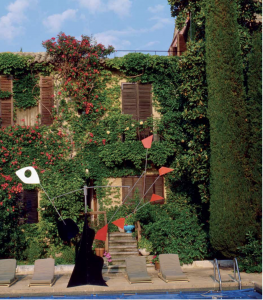-
Construction of ‘The Queen’s Terminal’ may not be grabbing the headlines, but Tom Jenkins finds plenty to shout about ahead of opening day
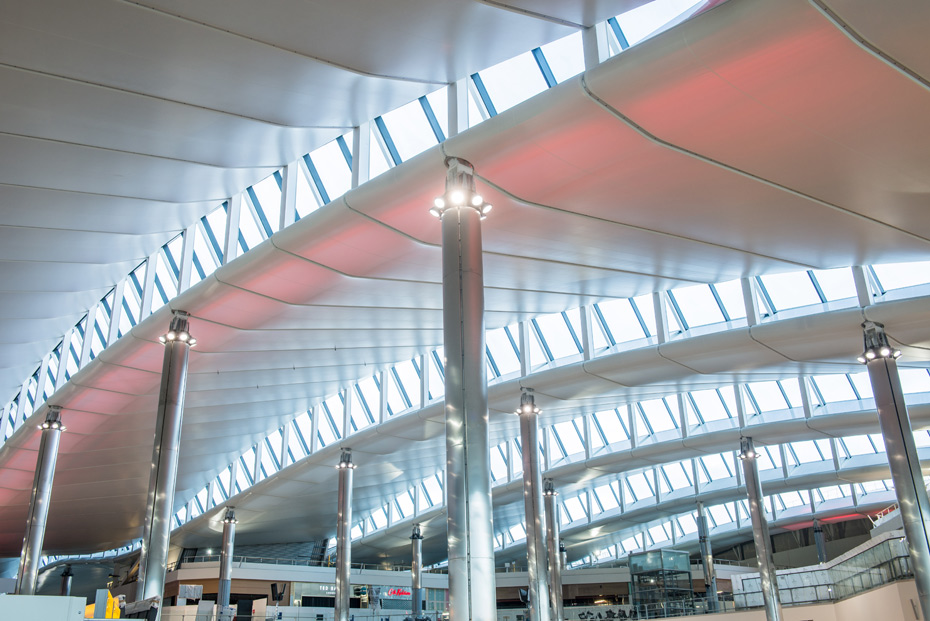 In the midst of bickering about airport expansion in and around London, the construction of a new terminal building at London Heathrow has flown somewhat under the radar. As environmental campaigners, business leaders and the Mayor of London face-off in the press over the need to increase Britain’s flight capacity, over in the west of the city the finishing touches are quietly being applied to Heathrow Terminal 2: The Queen’s Terminal – as quietly as one can work on a five year, £2.5 billion construction project at one of the world’s busiest airports.Of course, it’s no surprise that bosses are looking to downplay the 4 June opening of this new 44,000sq m hub, which replaces the original Terminal 2 building erected in 1955. In 2008 the airport’s then newest addition, the slick Rogers Stirk Harbour + Partners designed Terminal 5 opened with great fanfare before quickly descending into farce, with cancelled flights, lost baggage and queues of understandably angry (non) flyers snaking around the terminal building.
In the midst of bickering about airport expansion in and around London, the construction of a new terminal building at London Heathrow has flown somewhat under the radar. As environmental campaigners, business leaders and the Mayor of London face-off in the press over the need to increase Britain’s flight capacity, over in the west of the city the finishing touches are quietly being applied to Heathrow Terminal 2: The Queen’s Terminal – as quietly as one can work on a five year, £2.5 billion construction project at one of the world’s busiest airports.Of course, it’s no surprise that bosses are looking to downplay the 4 June opening of this new 44,000sq m hub, which replaces the original Terminal 2 building erected in 1955. In 2008 the airport’s then newest addition, the slick Rogers Stirk Harbour + Partners designed Terminal 5 opened with great fanfare before quickly descending into farce, with cancelled flights, lost baggage and queues of understandably angry (non) flyers snaking around the terminal building.
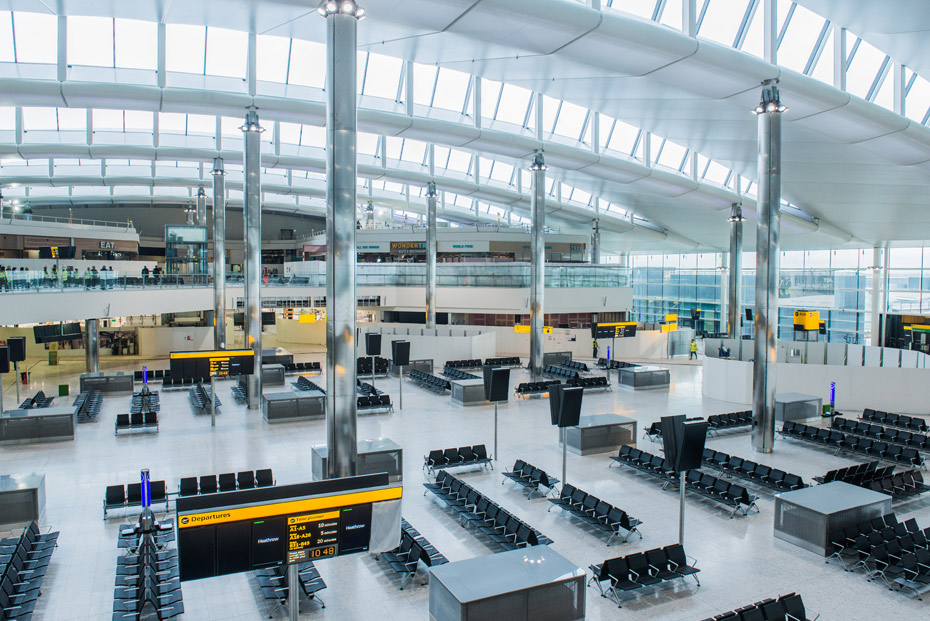 Terminal 2, part of a £11billion airport development programme, is expected to handle close to 20 million passengers a year and their ‘experience’ on the ground will be key to its success. Step forward Luis Vidal of Madrid-based Luis Vidal + Architects. The UK educated RIBA member, a specialist in transport infrastructure, is concept and lead architect on the project – his first in the UK. His award winning practice designs sustainable public buildings in which user wellbeing and intuitive wayfinding are paramount. Previous projects include Zaragoza and La Coruña Airports in his native Spain.“There’s been a revolution in terminal design,” says the softly spoken Vidal. “In the 1930s, airports combined arrivals and departures in a single building. Then in the 60s, this concept evolved to the segregation of circulation, whereby the arrivals were on one level of the building while the departures were on a different floor. In the 90s, commercial revenue became a priority and airport terminals became shopping malls. is the fourth generation of airports. Our concept converts an airport terminal into a destination unto itself, a place where people gather and spend time in a stress-free environment. Passengers will enjoy the balance between retail amenities and restaurants in a comfortable and approachable space integrated into the travel experience.”
Terminal 2, part of a £11billion airport development programme, is expected to handle close to 20 million passengers a year and their ‘experience’ on the ground will be key to its success. Step forward Luis Vidal of Madrid-based Luis Vidal + Architects. The UK educated RIBA member, a specialist in transport infrastructure, is concept and lead architect on the project – his first in the UK. His award winning practice designs sustainable public buildings in which user wellbeing and intuitive wayfinding are paramount. Previous projects include Zaragoza and La Coruña Airports in his native Spain.“There’s been a revolution in terminal design,” says the softly spoken Vidal. “In the 1930s, airports combined arrivals and departures in a single building. Then in the 60s, this concept evolved to the segregation of circulation, whereby the arrivals were on one level of the building while the departures were on a different floor. In the 90s, commercial revenue became a priority and airport terminals became shopping malls. is the fourth generation of airports. Our concept converts an airport terminal into a destination unto itself, a place where people gather and spend time in a stress-free environment. Passengers will enjoy the balance between retail amenities and restaurants in a comfortable and approachable space integrated into the travel experience.”
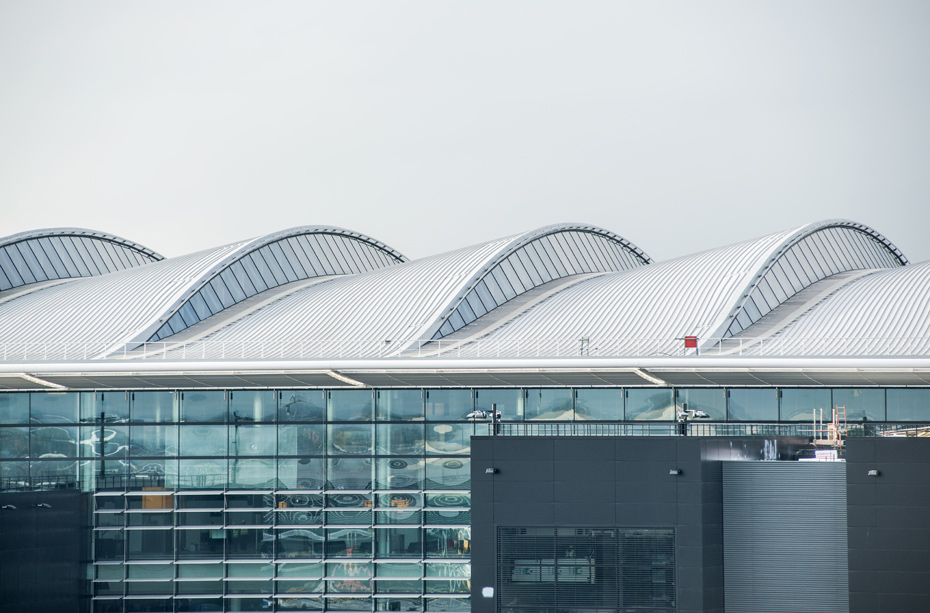 The new building is 40 per cent more carbon efficient than the old terminal and is the first airport terminal in the world to be awarded a BREEAM rating for sustainable design. The standout feature is an undulating steel-framed roof that floods the building with natural light. As well as reducing the need for artificial lighting the roof aids navigation through the various zones – check-in, security and boarding – via three vaults or ‘waves’. There’s a clear view of both the gates and the retail space from security (a rarity in many airports if you think about it) and no enclosed gate rooms. Essentially, passengers will have a visible route from drop-off to boarding.However, up to 40 per cent of those using the new terminal will be transferring between flights and thus won’t be entering or leaving the building. British Artist Richard Wilson, who today unveils a major new, aviation-inspired sculpture titled ‘Slipstream’ in Terminal 2’s Covered Court (which is actually open to the elements at either end), says making the right first impression is vital: “We’ve always boasted about London being a cultural capital and it’s interesting that it starts as soon as you get off the aeroplane. ‘Slipstream’ is a significant statement: ‘You have arrived in the cultural capital of the world.”
The new building is 40 per cent more carbon efficient than the old terminal and is the first airport terminal in the world to be awarded a BREEAM rating for sustainable design. The standout feature is an undulating steel-framed roof that floods the building with natural light. As well as reducing the need for artificial lighting the roof aids navigation through the various zones – check-in, security and boarding – via three vaults or ‘waves’. There’s a clear view of both the gates and the retail space from security (a rarity in many airports if you think about it) and no enclosed gate rooms. Essentially, passengers will have a visible route from drop-off to boarding.However, up to 40 per cent of those using the new terminal will be transferring between flights and thus won’t be entering or leaving the building. British Artist Richard Wilson, who today unveils a major new, aviation-inspired sculpture titled ‘Slipstream’ in Terminal 2’s Covered Court (which is actually open to the elements at either end), says making the right first impression is vital: “We’ve always boasted about London being a cultural capital and it’s interesting that it starts as soon as you get off the aeroplane. ‘Slipstream’ is a significant statement: ‘You have arrived in the cultural capital of the world.”
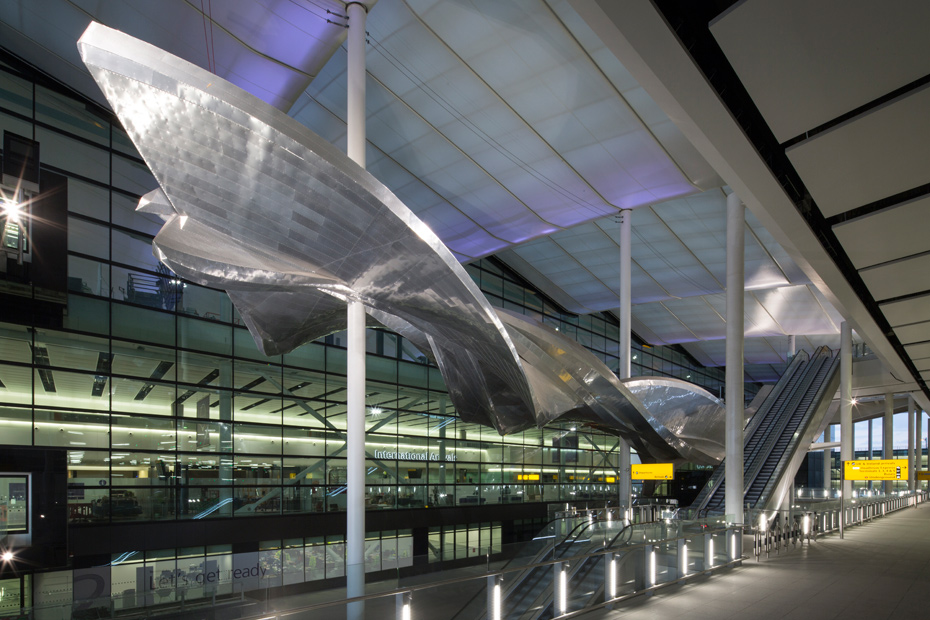 The aluminium sculpture, suspended from four central columns in the Covered Court, represents the imagined flight path of a Zivko Edge 540 stunt plane. It’s 78 metres long and weighs 77 tonnes. “I started thinking about the notion of the journey, the movement from A to B, from departure to arrival and vice versa. That’s really what the sculpture’s about,” he says. “The wonderful thing is, because it’s a movement that undulates and twists and turns, as you walk along it picks up the light coming in from the roof or from either end of the space and reflects it in all sorts of odd ways. It’s very beautiful, rather like seeing a fish skimming along under water.”A frequent flyer, Wilson is full of praise for the new terminal: “I do a lot of travelling, a lot of long haul – I’ve worked extensively in Japan. Once I’m on the plane I’m happy but I get quite nervous beforehand. Wherever you are in the world, once you get to an airport and you go ‘air side’ – through departures and into the lounges – you could be anywhere really. With the new Terminal 2, Luis Vidal has managed to stamp his authority on it and give it a very specific feel. It’s very relaxing; it’s very, very spacious.”
Above: Slipstream by Richard Wilson at Heathrow’s new Terminal 2: The Queen’s Terminal. David Levene
The aluminium sculpture, suspended from four central columns in the Covered Court, represents the imagined flight path of a Zivko Edge 540 stunt plane. It’s 78 metres long and weighs 77 tonnes. “I started thinking about the notion of the journey, the movement from A to B, from departure to arrival and vice versa. That’s really what the sculpture’s about,” he says. “The wonderful thing is, because it’s a movement that undulates and twists and turns, as you walk along it picks up the light coming in from the roof or from either end of the space and reflects it in all sorts of odd ways. It’s very beautiful, rather like seeing a fish skimming along under water.”A frequent flyer, Wilson is full of praise for the new terminal: “I do a lot of travelling, a lot of long haul – I’ve worked extensively in Japan. Once I’m on the plane I’m happy but I get quite nervous beforehand. Wherever you are in the world, once you get to an airport and you go ‘air side’ – through departures and into the lounges – you could be anywhere really. With the new Terminal 2, Luis Vidal has managed to stamp his authority on it and give it a very specific feel. It’s very relaxing; it’s very, very spacious.”
Above: Slipstream by Richard Wilson at Heathrow’s new Terminal 2: The Queen’s Terminal. David Levene
 Above: Luis Vidal’s architectural drawings for Heathrow Terminal 2 including Arrivals (bottom-left), Check-in and Security (bottom-middle) and Departures (bottom-right). © Courtesy of Luis Vidal + Architects
Above: Luis Vidal’s architectural drawings for Heathrow Terminal 2 including Arrivals (bottom-left), Check-in and Security (bottom-middle) and Departures (bottom-right). © Courtesy of Luis Vidal + Architects
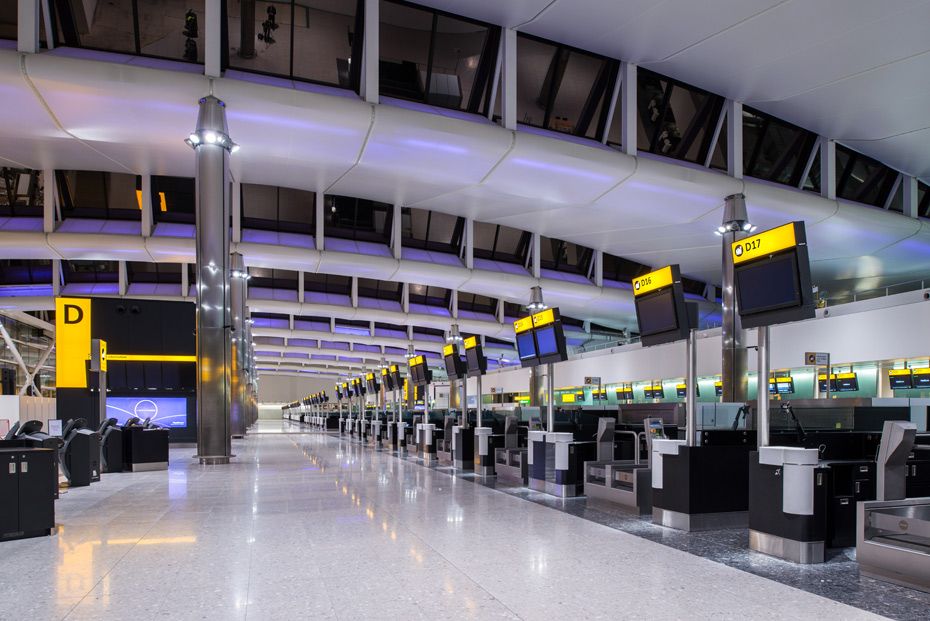 Vidal and his team had to address a number of site constraints: the close proximity of the Piccadilly Line running just seven metres below, height restrictions on both the structure and the cranes to allow a clear line of sight from the control tower, and the limitations of just one access tunnel running in and out of the site. The solution would set the heart of any 80s schoolboy aflutter. “One of the main technical features of the terminal’s design and construction is the use of prefabricated modules that contain the mechanical and electrical equipment,” says Vidal. “These pieces were easily assembled on site in a way not dissimilar to a Meccano set. This enabled a fast and economic build.”Vidal’s assertion that airports will become destinations unto themselves seems tenuous – one’s presence there will always be a necessity rather than a luxury – but a desire to make travel as enjoyable, enriching and stress-free as possible, whilst cutting emissions, is a noble cause. Here’s hoping Terminal 2 is a quiet, understated success.
Words Tom Jenkins
Vidal and his team had to address a number of site constraints: the close proximity of the Piccadilly Line running just seven metres below, height restrictions on both the structure and the cranes to allow a clear line of sight from the control tower, and the limitations of just one access tunnel running in and out of the site. The solution would set the heart of any 80s schoolboy aflutter. “One of the main technical features of the terminal’s design and construction is the use of prefabricated modules that contain the mechanical and electrical equipment,” says Vidal. “These pieces were easily assembled on site in a way not dissimilar to a Meccano set. This enabled a fast and economic build.”Vidal’s assertion that airports will become destinations unto themselves seems tenuous – one’s presence there will always be a necessity rather than a luxury – but a desire to make travel as enjoyable, enriching and stress-free as possible, whilst cutting emissions, is a noble cause. Here’s hoping Terminal 2 is a quiet, understated success.
Words Tom Jenkins
Subscribe to Port Magazine annually and receive each issue to your door.
Get PORT in print